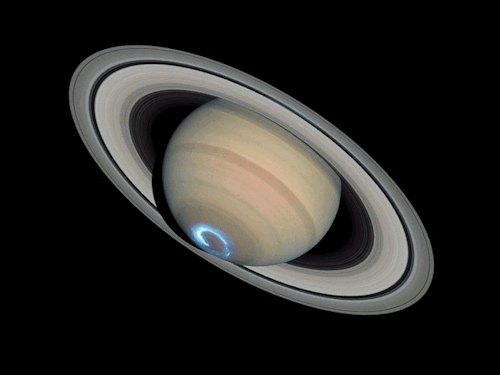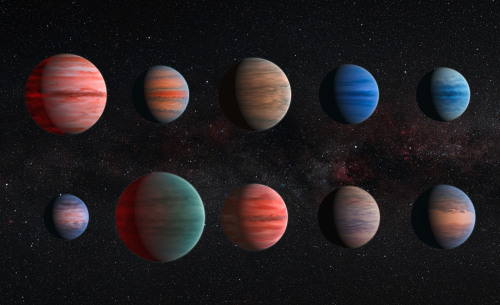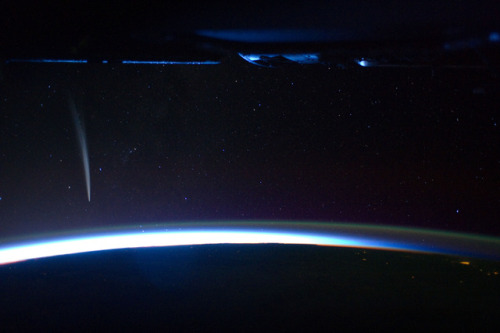Solar ❤


Solar ❤
More Posts from Xyhor-astronomy and Others
![Andromeda [x]](https://64.media.tumblr.com/aa70ce40e59ba0f9da6e334afac731fe/tumblr_ox11noOQXn1tuy5mao1_500.jpg)
Andromeda [x]
js

Sequence of images of auroras seen at the south pole of Saturn. Images combine visible and ultraviolet light.
Credit: NASA, ESA, J. Clarke (Boston University, USA), and Z. Levay (STScI)
What’s the deal about gravitational waves?
I guess y’all have heard about the discovery gravitational waves, and the recent observation of gravity waves linked to a visual observation as well.
What are they?
Gravitational waves are disturbances in space-time that are caused by objects in motion. Objects with mass distort spacetime, and thus when they move they also create disturbances. Think moving your hand along the surface of a pond - your hand’s motion creates waves and ripples in the water. Gravity waves were theorized by Einstein when he published his paper on General Relativity in the mid 1900s, and they were finally confirmed by LIGO about a year or two ago. The discovery of gravitational waves was considered the last major test of General Relativity, meaning that everything it’s predicted has held up to testing. As these gravity waves pass through space, they stretch it in one direction and compress it in the other. Check these two gifs out for a good visualization:



What is LIGO?
Ligo, or Laser Inferometer Gravity-wave Observatory, is one of three gravity wave observatories in the world. It works by splitting a laser into two perpendicular components. The light waves travel down long tunnels, bounce off a mirror, and recombine at the intersection. The interference pattern of the two light waves is measured (interference is how two light waves interact with each other - if the peaks and troughs line up, they cancel, but if the peaks line up they add together). When a gravitational wave passes by, it stretches everything in one direction while compressing it in the other direction, then vice versa. This causes a change in the interference pattern, which is then measured. Here’s a good diagram:

If you want more information about gravity waves, check out these videos:
Sources: Image 1 2 3 4, check out the links for good explanations.
Let me know if y’all have any questions!!! I’m happy to answer them.

Remnant of supernova toward the constellation of Vela, which exploded 11,000 years ago.
Image credit: NASA / Chandra x-ray Observatory

This image shows an artist’s impression of the 10 Hot Jupiter Exoplanets studied using the Hubble and Spitzer Space Telescopes. From the upper left to the lower right corner, these planets are WASP-12b, WASP-6b, WASP-31b, WASP-39b, HD 189733b, HAT-P-12b, WASP-17b, WASP-19b, HAT-P-1b And HD 209458b.
Credit: ESA / Hubble & NASA

Should there be a holiday called Astronomy Day?
Where lights are to be turned off for the entire night so everyone could see the stars?

Comet Lovejoy is visible near Earth’s horizon in this nighttime image photographed by NASA astronaut Dan Burbank, Expedition 30 commander, onboard the International Space Station on Dec. 21, 2011.
Image credit: NASA

A movie showing the dynamics of the inner part of the Crab Nebula made using the Chandra X-ray Observatory.
Credit: NASA/CXC/ASU/J.Hester et al.










Ask Ethan: Why don’t we build a telescope without mirrors or lenses?
“Why do we need a lens and a mirror to make a telescope now that we have CCD sensors? Instead of having a 10m mirror and lens that focus the light on a small sensor, why not have a 10m sensor instead?”
Every time you shine light through a lens or reflect it off of a mirror, no matter how good it is, a portion of your light gets lost. Today’s largest, most powerful telescopes don’t even simply have a primary mirror, but secondary, tertiary, even quaternary or higher mirrors, and each of those reflections means less light to derive your data from. As CCDs and other digital devices are far more efficient than anything else, why couldn’t we simply replace the primary mirror with a CCD array to collect and measure the light? It seems like a brilliant idea on the surface, and it would, in fact, gather significantly more light over the same collecting area. True, CCDs are more expensive, and there are technical challenges as far as applying filters and aligning the array properly. But there’s a fundamental problem if you don’t use a mirror or lens at all that may turn out to be a dealbreaker: CCDs without lenses or mirrors are incapable of measuring the direction light is coming from. A star or galaxy would appear equally on all portions of your CCD array at once, giving you just a bright, white-light image on every single CCD pixel.
It’s a remarkable idea, but there’s a good physical reason why it won’t pan out. For the foreseeable future, we still need optics to make a telescope! Find out why on this week’s Ask Ethan.

NASA’s Juno Probe Returns Stunning New Image of Jupiter
http://www.sci-news.com/space/juno-image-jupiter-05256.html
-
 veeshadirus reblogged this · 3 years ago
veeshadirus reblogged this · 3 years ago -
 astronomiaeciencia liked this · 4 years ago
astronomiaeciencia liked this · 4 years ago -
 adocosta reblogged this · 4 years ago
adocosta reblogged this · 4 years ago -
 adocosta reblogged this · 4 years ago
adocosta reblogged this · 4 years ago -
 adocosta liked this · 4 years ago
adocosta liked this · 4 years ago -
 lamigliorepartedime liked this · 5 years ago
lamigliorepartedime liked this · 5 years ago -
 cosmicspacekitty liked this · 5 years ago
cosmicspacekitty liked this · 5 years ago -
 eyeofthestorm888 liked this · 5 years ago
eyeofthestorm888 liked this · 5 years ago -
 dibble20 liked this · 5 years ago
dibble20 liked this · 5 years ago -
 tacitamura liked this · 6 years ago
tacitamura liked this · 6 years ago -
 metalzoic liked this · 6 years ago
metalzoic liked this · 6 years ago -
 fangirlsencyclopaediaofweirdness liked this · 6 years ago
fangirlsencyclopaediaofweirdness liked this · 6 years ago -
 yourlordvoldy-blog liked this · 6 years ago
yourlordvoldy-blog liked this · 6 years ago -
 covenawhite66 reblogged this · 6 years ago
covenawhite66 reblogged this · 6 years ago -
 covenawhite66 liked this · 6 years ago
covenawhite66 liked this · 6 years ago -
 dorkdoodles101 liked this · 6 years ago
dorkdoodles101 liked this · 6 years ago -
 gloomlaser liked this · 6 years ago
gloomlaser liked this · 6 years ago -
 davinschi liked this · 6 years ago
davinschi liked this · 6 years ago -
 nerdycashheroshepherd liked this · 6 years ago
nerdycashheroshepherd liked this · 6 years ago -
 roussi5 liked this · 6 years ago
roussi5 liked this · 6 years ago -
 kucukbirvedabusesi liked this · 6 years ago
kucukbirvedabusesi liked this · 6 years ago -
 the-chaos-goblin-child liked this · 6 years ago
the-chaos-goblin-child liked this · 6 years ago -
 fadinglandclamturkey-blog liked this · 6 years ago
fadinglandclamturkey-blog liked this · 6 years ago -
 mohamedfouad2100 reblogged this · 6 years ago
mohamedfouad2100 reblogged this · 6 years ago -
 mohamedfouad2100 liked this · 6 years ago
mohamedfouad2100 liked this · 6 years ago -
 speedrunner-fuchs-wulf liked this · 6 years ago
speedrunner-fuchs-wulf liked this · 6 years ago -
 ausevor liked this · 6 years ago
ausevor liked this · 6 years ago -
 diosita-de-la-lluvia liked this · 6 years ago
diosita-de-la-lluvia liked this · 6 years ago -
 iamdefinitelynotanalien liked this · 6 years ago
iamdefinitelynotanalien liked this · 6 years ago -
 thedoctorsawkwardhufflepuff liked this · 6 years ago
thedoctorsawkwardhufflepuff liked this · 6 years ago -
 simonflow liked this · 6 years ago
simonflow liked this · 6 years ago -
 mc-marqs reblogged this · 6 years ago
mc-marqs reblogged this · 6 years ago -
 mc-marqs liked this · 6 years ago
mc-marqs liked this · 6 years ago -
 jordyng97 liked this · 6 years ago
jordyng97 liked this · 6 years ago -
 plumdumbling reblogged this · 6 years ago
plumdumbling reblogged this · 6 years ago -
 plumdumbling liked this · 6 years ago
plumdumbling liked this · 6 years ago -
 superiorstick liked this · 6 years ago
superiorstick liked this · 6 years ago -
 erebirebbak liked this · 6 years ago
erebirebbak liked this · 6 years ago
For more content, Click Here and experience this XYHor in its entirety!Space...the Final Frontier. Let's boldly go where few have gone before with XYHor: Space: Astronomy & Spacefaring: the collection of the latest finds and science behind exploring our solar system, how we'll get there and what we need to be prepared for!
128 posts